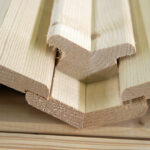Types of Waterstop Materials
General introduction:
Waterstop is a water-resistant material used to prevent water from penetrating through gaps, expansion joints or seams in construction works. Waterstop is often used in load-bearing structures such as basements, swimming pools, water tanks, dams, underground pipes and other underground structures to ensure waterproofing properties for the project.
Waterstop materials are usually made from rubber, PVC or metal that are resistant to water penetration. When used in construction, waterstops are placed in locations that need to prevent water and are sealed or connected with other materials to form a waterproof barrier.
Waterstop has many advantages, including the ability to withstand high water pressure, durability and longevity, resistance to water penetration whether in chemical or seawater environments, and the ability to withstand water damage. elasticity and expansion of the surrounding structure.
The use of waterstop is an important part of the waterproofing process in construction, ensuring the safety and durability of the project in the long term.
There are many types of water blocking materials used in construction, each designed for specific applications and conditions. Below are some popular types on the market.
PVC waterstop
PVC waterstops are the most commonly used waterstops in construction because they are made from polyvinyl chloride (PVC), a durable and flexible material that is resistant to certain chemicals and elements. environmental factor. PVC water stoppers come in many different shapes, including hollow spheres in the middle, 2-sided shields and 1-sided shields to suit different construction locations. They are easy to install, cost-effective and have excellent resistance to hydrostatic pressure.

TPV waterstop
Thermoplastic vulcanized (TPV) water barrier (also known as TPE-R), is a material with greater flexibility and durability than conventional water barrier, TPV water barrier has very good resistance for many chemicals, solvents and hot petroleum. TPV water stoppers come in many different shapes, including hollow spheres in the middle, 2-sided shields and 1-sided shields to suit different construction locations. They are easy to install and have excellent resistance to hydrostatic pressure.

Butyl rubber is hydrophilic:
Butyl waterstop is a type of waterstop material that uses its natural swelling properties to seal joints and prevent water intrusion. They come in the form of round, square or flat fibers of different lengths, often installed in concrete joints, drainage pipe installation locations… with a self-inflating mechanism when exposed to water to create watertight barrier right where they are placed.
Butyl rubber has good bending ability, making it easy to install in necessary positions in the project.
Not all types of Butyl rubber are resistant to strong chemicals, so it is necessary to choose a type suitable for the usage environment.

Metal waterstop:
This waterstop material is a type of waterstop that uses metal, such as copper or stainless steel, to create a barrier against water intrusion. They come in many different shapes, suitable for each construction location and are often used in projects that require a high level of chemical resistance, such as in chemical plants or treatment plants. Sewage.
Because metal can conduct heat, it increases the risk of water condensation and water marks forming on the surface. The weight is heavier than other materials such as rubber and plastic, leading to difficulties during transportation and installation.
Construction of metal waterstops may require more careful preparation and higher techniques than other types of materials, especially in areas that need to be curved or folded.

Conclusion:
Choosing the right type of water blocking material not only helps protect the building from the risk of water infiltration but also creates favorable conditions for the construction and maintenance process later. Each type of material has different advantages, suitable for each location of each project. We need to understand the properties of each type of material so we can choose the most suitable one for our project.
Choosing the right type of water blocking material is very important, because it affects the quality of the entire project. It not only helps prevent water infiltration at the construction site but also protects the entire construction system during use.
Above all, the use of waterstop and other water blocking materials plays an important role in the construction of highly waterproof structures, contributing to the sustainability and safety of the structure over time. long.
If your project does not use the right type of water blocking material, the consequences can be major safety and cost risks in the future. Water seepage can cause serious problems such as leaks, dampness, mold, and even structural damage. This not only affects the aesthetics of the project but also threatens its safety and sustainability. Don’t let these risks happen. Please contact us immediately for advice and to provide the best and most suitable type of waterstop, at the most reasonable price, ensuring safety and durability for your project.



